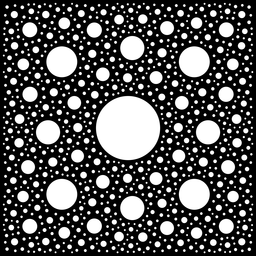Crate space_filling
source ·Expand description
This is a library for generalized space filling in ℝ² (do not mix with packing).
It is split into two main modules: solver for generating a distribution of shapes,
and drawing for displaying it (requires draw feature).
Here, “shape” denotes one or multiple regions of ℝ² space, that can be represented by a
signed distance function.
Basic usage, Argmax2D solver
let path = "out.png";
/**
* Initialize instance of `Argmax2D`, which will store the discrete distance field in
* a 1024x1024 bitmap, and 16x16 chunk size.
* Resolution must be divisible by chunk size.
* Resolution affects the precision of solver, and is not related to final picture size.
* Chunk size is only important for optimization. Best values depend on the actual
* system configuration, but typically `chunk = resolution.sqrt() / 2`
**/
let mut representation = Argmax2D::new(1024, 16)?;
// prevent shapes from escaping image
representation.insert_sdf(sdf::boundary_rect);
// Initialize image buffer, which will hold final image.
let mut image = image::RgbaImage::new(2048, 2048);
// Generate the distribution of shapes:
for _ in 0..1000 {
// find global maxima of the field
let global_max = representation.find_max();
// Make a new circle at the location with highest distance to all other circles.
let circle = Circle
.translate(global_max.point.to_vector())
.scale(global_max.distance / 4.0);
/** Update the field.
* `Circle` impletemens the `SDF` trait. Additionally, it has been concluded that
* only a certain part of the field is being changed every time, depending on the
* current maximum distance. To be exact - a square region with a side of
* max_dist * 4.0 * sqrt(2.0), which made possible achieving
* greater speed of computation. **/
representation.insert_sdf_domain(
util::domain_empirical(global_max),
|v| circle.sdf(v)
);
circle
.texture(Luma([255u8]).to_rgba()) // fill with white color
.draw(&mut image); // draw the shape on image
}
image.save(path)?; // save imageGD-ADF solver
let path = "out.png";
let mut representation = RwLock::new(ADF::<f64>::new(5, vec![Arc::new(sdf::boundary_rect)]));
let mut image = image::RgbaImage::new(2048, 2048);
// In case of GD-ADF, it is adviced to use `util::local_maxima_iter`,
// as it is capable of finding multiple local maxima in parallel.
// By default, this is an infinite iterator.
util::local_maxima_iter(
// provide a closure for sampling distance field
Box::new(|p| representation.read().unwrap().sdf(p)),
32, 0, LineSearch::default()
).filter_map(|local_max| {
let circle = Circle
.translate(local_max.point.to_vector())
.scale(local_max.distance / 4.0);
// Update distance field. Since the precision is not perfect, sometimes update may fail -
// thus Option is returned
representation.write().unwrap().insert_sdf_domain(
util::domain_empirical(local_max),
Arc::new(move |p| circle.sdf(p))
).then(|| circle)
}).take(1000) // stop, once 1000 circles were successfully added
.for_each(|shape| shape
.texture(Luma([255u8]).to_rgba())
.draw(&mut image)
);
image.save(path)?;

Drawing
Drawing was intended to be a rudimentary module for displaying sdf shapes. It is not highly optimized, and you are free to use third-party libraries for this purpose.
There are two traits related to drawing:
traitShape:SDF+BoundingBoxtraitDraw:Shape`
Draw is primarily implemented on Texture:
.texture(Rgba(...)) -> Texture<T, Rgba<u8>>
.texture(image) -> Texture<T, image::DynamicImage>
.texture(|pixel| { ... }) -> Texture<T, Fn(Point2D) -> Rgba<u8>>
At first, you could think writing:
let shapes: Vec<Box<dyn Shape>> = vec![
Box::new(Circle.translate(...).scale(...)),
Box::new(Square.translate(...).scale(...))
];
for shape in shapes {
shape.texture(...)
.draw(...);
}But this won’t work, because all of Shape methods require Sized, hence no object safe.
Correct way is:
let shapes: Vec<Box<dyn Draw<RgbaImage>>> = ...However, since Rust never got a support of trait upcasting, we cannot obtain dyn Shape from
dyn Draw, hence somewhat limited in capabilities.
Lastly, there is: draw_parallel, which is convenient when shapes
require heavy computations to draw, such as texture loading. It accepts an iterator on
dyn Draw<RgbaImage> + Send + Sync, constructed via trait object casting, exactly as above.
See examples/argmax2d/03_embedded.rs, examples/gd_adf/04_polymorphic.rs and
drawing/tests::polymorphic_* for more details.
This way, both distribution generation and drawing are guaranteed to evenly load all available cores.
Have a good day, nyaa~ =^_^=

Modules
- drawing
drawing - .